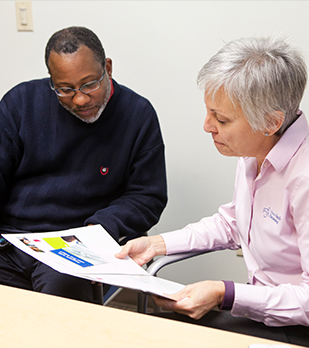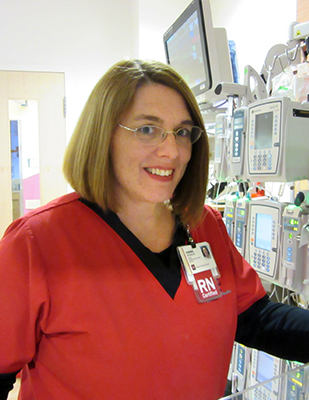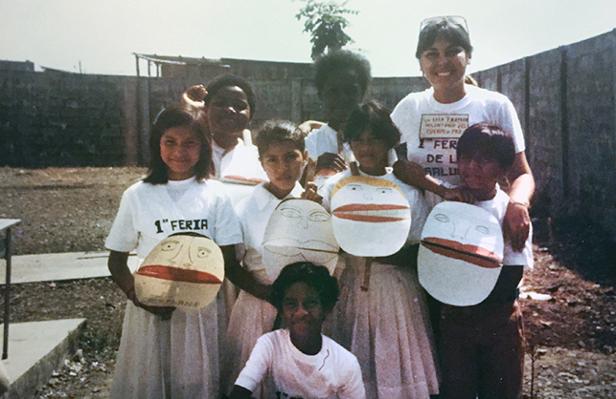At the bedside and beyond
Alumnae demonstrate leadership
Written by Story by Becky Brown
“The nursing profession must produce leaders throughout the health care system, from the bedside to the boardroom.” So proclaimed a 2010 study by the Institute for Medicine. These three School of Nursing alumnae — each at a different stage of her career and working with a different patient population — exemplify leadership in the field, as they apply expertise and confidence gained at Purdue to improve care, quality of life and the future of health care.
Leading an evidence-based, home-visit program for new mothers

When Lisa Crane (BSN ’82) completed her studies, she didn’t immediately start work at a hospital or clinic. Instead, she joined the Peace Corps, serving for two years in Ecuador. It marked the beginning of a lifelong commitment to public health.
“During my bachelor’s program, it became clear to me that I wasn’t drawn to inpatient nursing, but instead to making a difference in the community,” says Crane, the 2014 Distinguished Alumni and Golden Graduate award winner. “I entered nursing without any definite plan, but looking back, it’s clear my Purdue education gave me the technical and leadership skills I needed, and the Peace Corps set me on the path to working with the underserved.”
In 2011, that path led her to the Nurse-Family Partnership, an international community health program implemented exclusively in Indiana through Goodwill of Central & Southern Indiana. The program — which began in Marion County and has since expanded to Delaware, Lake, Madison, Tippecanoe and White counties — pairs first-time, low-income mothers with registered nurses.
Nurses conduct home visits beginning early in a mother’s pregnancy and continuing through her child’s second birthday, with the goal of providing the best start for children during their most developmentally critical years.
Crane, who serves as the Nurse-Family Partnership’s senior director in Indiana, was drawn to the program’s proven results in improving not just birth outcomes but also long-term child health and development and family self-sufficiency. Extensive research conducted over the past three decades, including randomized, controlled trials with three diverse populations, points to improved prenatal health, fewer childhood injuries, increased maternal employment and improved school readiness.
“We’re involved in real, primary prevention of problems, and we’ve demonstrated our ability to achieve good outcomes,” Crane says. “For every dollar invested in the Nurse-Family Partnership, there’s a long-term return of $5 to $6.”
That prevention-focused, outcome-driven model is the way Crane believes the health care industry as a whole must move.
“Health spending has always been pay for service — you pay for a doctor’s visit, for a test, for treatment and medication,” she says. “The direction many health economists and nursing leaders agree we should be headed is toward pay for performance. In the long term, that’s the only way we can sustain health care in this country.”
Proving the value of nursing in patient safety and quality care

After 30 years of nursing, all at Riley Hospital for Children in Indianapolis, Connie Neuzerling (BSN ’86) still enjoys time spent at a patient’s bedside more than any other aspect of her profession. Today, she serves as a clinical coordinator in the cardiovascular critical care unit — a role that allows her to work with other nurses to deliver patient care while teaching them about new procedures and equipment.
“Part of my job still involves bedside nursing, and that’s important to me as an educator because I want to stay relevant,” Neuzerling says. “Purdue instilled in me a lifelong learning attitude. There’s always something to learn from your patients and their physicians.”
That willingness to invest in her patients is a major reason Neuzerling was named Indiana Nurse of the Year at StarMedia’s 2016 Salute to Nurses event. She was nominated by a co-worker whose daughter with cerebral palsy was a longtime patient at Riley.
“She was distraught by what was happening to her daughter physically and was dealing with financial issues at the same time,” Neuzerling says. “I just talked with her and helped her work through some of those problems. I tried to give her hope for the future and show her daughter the possibilities for living with this disease.”
As she watches health care organizations take steps to cut costs, Neuzerling is concerned that the role she and her fellow nurses play in ensuring quality care and patient safety isn’t always recognized — even though extensive research clearly shows its value. According to the American Nurses Association, higher nurse staffing levels are tied to fewer patient falls, a reduction in infections and medication errors, and even fewer deaths.
Cutting bedside nurses is the easiest thing to do because we’re the biggest budget item,” Neuzerling says. “We have to speak up and show our worth, and that means taking part in research and improvement projects. Nurses do so many things every day that people just don’t see — we need to put them down on paper and prove how critical our role is.
Serving as an advocate for patients at every stage of life

For Megan Klotz (BSN ’16), her first few months as a practicing nurse in the neurology unit at Carle Foundation Hospital in Urbana-Champaign, Illinois, have been eye-opening.
“I didn’t realize how often I’d have to be an advocate,” says Klotz, the 2016 College of Health and Human Sciences Outstanding Senior in Nursing. “So many people lay hands on your patients, and as the nurse, it’s your job to make sure the right people are laying the right hands on the right patients for the right reasons.”
Early on, Klotz’s willingness to take on that advocacy role helped prevent one of her patients from dying of anaphylactic shock.
Concerned that something “felt off” with the patient, she called the physician and brought in several other nurses, all of whom told her not to worry. Despite their reassurances, Klotz kept digging — eventually uncovering a drug reaction when reviewing the patient’s chart.
“My gut was telling me something wasn’t right, and my professors at Purdue said always to listen to your gut,” she says. “It sounds silly, but very often on my shift, I can hear my professors whispering in my ear and then the light bulb clicks.”
Klotz hopes to focus her advocacy efforts on care for older adults, a critical need given the nation’s rapidly aging population. According to the Administration on Aging, one in five Americans will be 65 or older by 2030. The American Association of Colleges of Nursing reports that while 63 percent of newly licensed RNs work predominantly with older adults, only 1 percent are certified in gerontological nursing.
Klotz credits her Purdue professors with helping her find and follow her passion for gerontology — including her involvement as a student with the National Gerontological Nursing Association.
“I just have a fascination with the older adult body and a respect for the older mind and soul,” she says. “We need to view aging as a beautiful process and look at the end of life with just as much importance as the beginning of life. So many nurses have a passion for pediatrics, and parents of sick kids know that those nurses will love their children like their own. You don’t always feel that way when your grandparents or parents are ill. I want my patients to know how excited I am to take care of them.”
